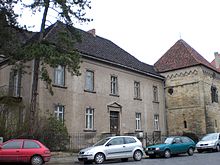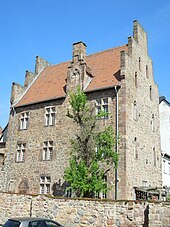Curia (building)
As Curia were designated the home of a Säkularkanonikers , a canon or a canoness ; mostly it was representative individual buildings in the immunity area around the church.
Säkularkanoniker at a collegiate , even collegiate or Canons called to a pin chapters were secular priests, while as a community at a particular Collegiate Church lived and for the local church services were responsible, but unlike canons regular no vows took off, no religious priests or monks were and could leave the pen freely at any time. The assembly of canons, the so-called collegiate chapter, administered the assets of the collegiate church, but the individual canons , unlike religious priests , kept their private assets. Since secular canons were originally mostly born after sons of noble families, and later also came from the wealthy bourgeoisie, they placed great value on an appropriate residence of their own, a so-called curia, near the monastery. In addition to a garden, the curia mostly also had outbuildings that were used as stables , coach houses or accommodation for servants.
Noteworthy curiae are still preserved today. B. in:
- Bamberg : the Domherrenhöfe on Domplatz, in Domstraße and in Oberen Karolinenstraße as well as the Stiftsherrenhöfe in the immunities of St. Gangolf and St. Stephan,
- Brandenburg an der Havel : on the cathedral island,
- Fritzlar : Gothic curia in Kasseler Strasse and Fischgasse,
- Lübeck : the core of the so-called Palais Rantzau ,
- Naumburg (Saale) : the Aegidia Curia ,
- Speyer: after the destruction in the Palatinate War of Succession, some canons' curiae were elaborately rebuilt in Speyer in the 18th century; z. B. the curia "Zum Großen Birnbaum" (Domplatz 3) and the curia "Zum Engel" (Große Pfaffengasse 13).
- Trier : Cathedral district, largely closed, with curiae, which are mostly named after the families of the residents.
Footnotes
- ↑ Palatinate Monastery Lexicon: Handbook of the Palatinate Monasteries, Pens and Comingians / ed. by Jürgen Keddigkeit, Matthias Untermann, Charlotte Lagemann .... - Kaiserslautern 2014, Volume 1, p. 14. and Untermann, Matthias: Handbook of medieval architecture. Darmstadt 2009 p. 151 f.
- ^ Untermann, Matthias: Handbook of medieval architecture . Darmstadt 2009, p. 151 f.
- ↑ Palatinate Monastery Lexicon: Handbook of the Palatinate Monasteries, Pens and Comingians / ed. by Jürgen Keddigkeit, Matthias Untermann, Charlotte Lagemann .... - Kaiserslautern 2017, Volume 4, p. 214 f. and Klotz, Fritz: Domkapitularische Höfe, houses, house squares and gardens in Speyer in the 18th century. Speyer 1991, pp. 28, 40


